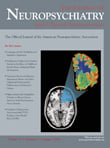ECT Treatment for Two Cases of Dementia-Related Pathological Yelling
To the Editor: Current guidelines support the use of ECT in individuals with mood disorders unresponsive to pharmacologic treatments. 1 Recently, ECT has been identified as an effective intervention for medication refractory verbal and physical agitation in patients with dementia, developmental disability, and traumatic brain injury. 2 , 3 Behavioral dyscontrol presenting as verbal agitation (inappropriate vocalizations or chronic hollering unexplained by other causes) is a common and troublesome dementia-related condition and is difficult to manage in a long-term care setting. 4 Among patients demonstrating extensive episodes of verbal agitation secondary to dementia or other underlying illnesses (namely major depression or bipolar mania), the primary intervention after the failure of nonpharmacological measures is the judicious use of evidence-based medications. 5 ECT use is generally reserved for refractory circumstances or when medications are poorly tolerated. 6 We report two cases of successful use of ECT for patients with dementia who demonstrated severe verbal agitation and presented no known previous history of major depressive or mood disorders.
Case 1
Ms. A is an 88-year-old woman with no previous psychiatric admissions and a 6-year history of probable Alzheimer’s disease dementia and Parkinson’s disease. She was transferred to the medical psychiatry unit from a nursing facility for treatment of behavioral dyscontrol. She exhibited 2 months of increasing verbal agitation in the form of screaming, hollering obscenities, and palilalia. Her screaming periods would last over 45 minutes, several times daily, and she was unresponsive to comfort measures or reassurance. Two months prior to admission she was treated with risperidone and then quetiapine with no improvement. A trial of escitalopram was ineffective. Subsequent trials of olanzapine and divalproex were similarly ineffective.
Her medications on admission included those previously mentioned as well as spironolactone, ranitidine, oxycodone, lorazepam, memantine, and carbidopa/ L -dopa (sinemet). Her neurocognitive evaluation on admission was noteworthy for signs of global cognitive impairment secondary to cortical degenerative dementia. Parkinsonian symptoms were evident. She did not demonstrate evidence of pain and all laboratory work was within normal limits. A brain CT indicated diffuse cortical volume loss with secondary ventricular enlargement.
ECT treatment for her behavioral dyscontrol was started. She underwent 11 treatments with bilateral lead placement. Seizure durations lasted up to 84 seconds. The staff noticed marked changes in her verbal behavior by the second ECT treatment when she looked at a peer and spoke in grammatically correct sentences at a normal volume. She began to socialize with visitors without verbal agitation. Her parkinsonian symptoms were not diminished by ECT.
Case 2
Ms. B is an 80-year-old single woman with no previous psychiatric admissions and a history of congestive heart failure, hypertension, renal failure, osteoarthritis, hypothyroidism, and developmental disability secondary to congenital hydrocephalus. She was transferred to the medical psychiatry unit from her group home for a several-week history of yelling and screaming with no known precipitants. She became increasingly agitated prior to admission by screaming, spitting, and occasionally striking at staff. Providing comfort measures and redirection were unsuccessful. Trials of haloperidol and thioridazine were ineffective. When her verbal agitation escalated to the point of disrupting the group home environment, she was referred for admission.
On admission, the patient was alert, groaning, and attempting to hit staff. Her speech was loud, disarticulate, and notable for a fluent aphasia. She would repetitively yell “get out.” Her medications upon admission included ranitidine, levothyroxine, sertraline, and thioridazine. Laboratory results were within normal limits and a brain CT revealed microcephaly, asymmetrically enlarged ventricles, and dilated left frontal and right occipital horns of the lateral ventricles, which was consistent with prior studies.
She was tapered off thioridazine and sertraline and received five ECT treatments with bilateral lead placement. Seizure durations were up to 56 seconds. Ms. B returned to baseline, becoming cooperative and pleasant with staff, and tolerated visits from her sister, stating that she wanted to “go home.” She began to respond to her name and nod in response to questions with no evidence of verbal agitation or verbal aggression.
Conclusion
In these two cases, ECT was successful when multiple pharmacological interventions failed. The treatments were well tolerated and led to marked improvement in quality of life for these two patients. They were discharged to their respective facilities without the need for daily psychotropic medications and they were both referred for maintenance ECT.
Discerning the etiology of verbal agitation in the setting of advanced dementia is difficult because chronic verbal agitation may be the result of psychosis, mania, an agitated depression, physical discomfort, or disinhibition. ECT is rarely considered as an intervention for severe, refractory behavioral dyscontrol in patients with dementia though its use is considered safe, with fewer potential side effects, and more cost-effective than psychopharmacology alone. 7 , 8 It is our impression that ECT be considered earlier rather than later in the course of treating verbal agitation in elderly patients with dementia who do not respond adequately to environmental, behavioral, or pharmacologic measures.
1 . Scott AIF: Electroconvulsive therapy. Psychiatry 2006; 5: 208–211Google Scholar
2 . Carlyle W, Killick L, Ancill R: ECT for screaming in dementia. Am J Geriatr Psychiatry 2000; 8:177Google Scholar
3 . Lombard LA, Zafonte RD: Agitation after traumatic brain injury: considerations and treatment options. Am J Phys Med Rehabil 2005; 84:797–812Google Scholar
4 . Tariot PN: Treatment of agitation in dementia. J Clin Psychiatry 199; 60(suppl 8):11–18Google Scholar
5 . Schloss P, Fritz AH: New insights into the mechanisms of antidepressant therapy. Pharmacol Ther 2004; 102:47–60Google Scholar
6 . Zisselman MH, Kelly KG, Cutillo-Schmitter T, et al: Successful ECT in long-term care residents. J Am Med Directors Assoc 2001; 2:22–25Google Scholar
7 . Daniel M, Hellgren K, Nyback H: ECT: a treatment of choice in contemporary psychiatry? European Psychiatry 1996; 11(suppl 4):338Google Scholar
8 . McDonald WM, Philips VL, et al: Cost-effective maintenance treatment of resistant geriatric depression. Psychiatry Ann 1998; 28:47–52Google Scholar



